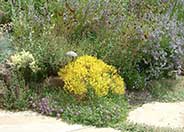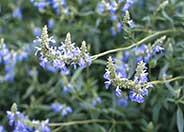
Common name:Ferned-Leaved Tickseed
Botanical name:Bidens ferulifolia 'Goldmarie'
Tickseed grows 14'-18" tall. It is a heat tolerant variety that is perfect for cascading, bright color in baskets, containers, and window boxes. Finely divided foliage is covered with gold, single flowers. It blooms until first frost. Plant in full sun. It needs well-drained soi.

Common name:Rock Purslane
Botanical name:Cistanthe grandiflora 'Jazz Time'
This perennial will grow 12"-36" and produces large blue-green rosettes that last for a long season. It produces large, silky, lavender pink flowers that have lime-green, purple spotted calyces.

Common name:Coast Sunflower, Coast Encelia
Botanical name:Encelia californica
Encelia californica is a fast growing woody subshrub with bright green foliage and yellow daisy-type flowers. It can be used effectively in the natural landscape with regular pruning to maintain form. It is more commonly used in native restoration work. In inland situations, it requires more regular water. It grows to 4' tall and wide.
Maintenance Tips
Encelia californica is a California native shrub that grows quickly up to 4' wide. It will look and perform its best when planted in full sun in well-drained soil with enough space to reach its mature size. It is very drought tolerant once established and rarely has any pest or disease issues. This shrub has lots of cross-branching and can grow very dense in just one growing season. Pruning throughout the growing season is discouraged as it will affect the amount of blooms that emerge. This is the type of shrub that can resemble a tumbleweed when the blooming cycle ends. Cutting it back hard in the early fall will remove many of the woody branches and will encourage new growth to occur. There is no need to fertilize as the plant will perform very well without supplemental nutrients in almost all soil conditions.
Common name:Red Star Autumn Sage
Botanical name:Salvia greggii 'Red Star'
This shrub will grow 1'-4' tall and 1'-4' wide. It has glossy green leaves with red flowers that bloom from fall to spring.

Common name:Pacific Coast Irises
Botanical name:Iris Pacific Coast Hybrids
These Irises are 6"-18" tall and have clumps of grass-like foliage. The flowers are 3"-4" across; it makes good cut flowers and vary from white, yellow, lavender, purple, blue, and reddish purple.

Common name:Western Redbud
Botanical name:Cercis occidentalis
This deciduous shrub or small tree ranges from 6'-10' tall and wide. It is desirable for its magenta spring flowers, yellow to red fall color, and dangling winter seed pods. It is tolerant of many soil types, drought and oak root fungus. It attracts hummingbirds and butterflies. The Western Redbud can be found statewide in CA in the foothills below 4500' elevations in chaparral and woodland communities.
Maintenance Tips
Cercis occidentalis is a very popular California native deciduous tree. The natural form of this plant is that of a multi-branching shrub; however, it is often shaped to be a single trunk so it can be used in many garden spaces. The best way to keep the maintenance low with this tree is to plant it in a sunny location that has well-drained soil and give it the room it needs to reach its mature size. It is fairly pest and disease-resistant and performs very well as a specimen tree in native gardens. The pruning recommendations will depend on the shape of the specimen. If the tree has the multi-trunk, shrub form, the mature height can be 6-10' tall and wide and will naturally grow into a round, compact form. These forms benefit greatly from the thinning method, removing cross-branching or the longer branches to manage the plant's size. The cuts should be made towards the center of the plant, allowing sunlight into the interior. The single trunk form should be pruned the same way, but it will mature much larger and eventually should be pruned by a licensed arborist. Both forms will lose their leaves in the winter, so this is usually the easiest time to prune since the foliage is out of the way.
Common name:Blue Fescue
Botanical name:Festuca glauca
This ground cover/grass will grow less than 1' tall and has small, blue green leaves.
Maintenance Tips
Festuca glauca is a perennial clump-forming grass. It has soft straw-like leaves that form a blue-green dome that can get up to about 10 inches wide and tall. They prefer full sun and well-drained soil, but can tolerate slight shade, drought conditions, and poor soil nutrition. These will send out flower stalks in the summer, which should be cut back to the base after a few months to give them a cleaner appearance. They will also benefit from having any dead leaves pulled from the plant at any time of year, but the fall is typically the best time to clean up the foliage. It is short-lived in the landscape, with a lifespan of about 2-4 years after which it dies out in the center. Some might dig up and divide the living edges into several new plants, but most of the time it is easier to replace with a new one.
Common name:Spoon-Yucca
Botanical name:Dasylirion wheeleri
Spoon-Yucca requires little maintenance, as it tolerates drought, reflected heat and poor soils. It develops a short, thick trunk while reaching 6' tall and wide. Leaves are linear gray-green to 3' long and armed. During late spring and summer, erect stems of white creamy flowers are visible. It is a long lived shrub and slow-growing. It needs a well-drained site; it is cold and drought hardy.

Common name:Sage
Botanical name:Salvia uliginosa
This clumping plant with straight stems of 6'-7' and narrow, bright green leaves is a favorite of hummingbirds. These highly aromatic leaves are accented by pale blue and white flowers. The flowers are arranged in 7" long, branched clusters. This plant blooms throughout the entire summer.
Designer: The Plant Nerd
Photographer: GardenSoft